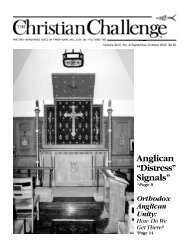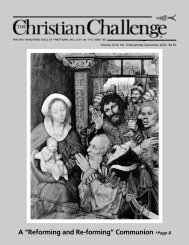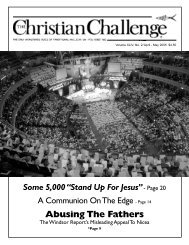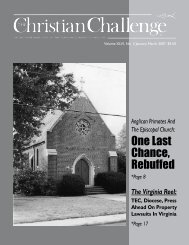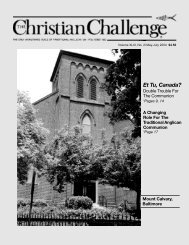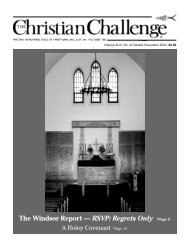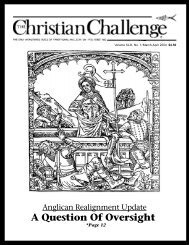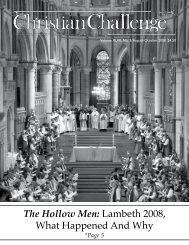Church Planting For The 21st Century - The Christian Challenge
Church Planting For The 21st Century - The Christian Challenge
Church Planting For The 21st Century - The Christian Challenge
Create successful ePaper yourself
Turn your PDF publications into a flip-book with our unique Google optimized e-Paper software.
NOW WITH MORE THAN 1 0 members, AMiA’s Holy Trinity Anglican <strong>Church</strong>, Hudson, Ohio, was established in December 200 and its church<br />
building was purchased and remodeled by May 2006. Holy Trinity is led by the Rev. Doc Loomis. Photo courtesy of Holy Trinity and AMiA<br />
tribute this to the Lord’s grace and His guidance, along with<br />
a clear goal and message, a specific model centered on small<br />
groups, professional coaching, and a clear focus – we keep<br />
our eyes on the ball.<br />
<strong>The</strong> Bedrock Values<br />
Anglican Mission offers a unique blend of the ancient and<br />
future, and inherent in our church plants is our commitment to<br />
unity in the essentials of the <strong>Christian</strong> Faith as well as a willingness<br />
to allow diversity in our expression of that faith. We envision the<br />
evangelical, catholic and charismatic forms of worship as three<br />
streams flowing from one river – Jesus Christ and His Gospel<br />
imperatives. We are committed to the authority of Scripture,<br />
worship in Word and Sacrament along with Spirit-led evangelism,<br />
discipleship and service. Based on a careful study undertaken<br />
by the Rt. Rev. Dr. John Rodgers, the Anglican Mission has<br />
determined that the most faithful response to the witness of<br />
Scripture and its teaching on headship would dictate that women<br />
be ordained only to the diaconate. While recognizing that the<br />
<strong>Church</strong> is presently seeking further clarity in this matter through<br />
a period of discernment and “reception,” the important concept<br />
of “headship” proved to be the most critical issue for us as we<br />
developed our policy on the issue of women’s ordination.<br />
WE UPHOLD and live specific values that form our<br />
DNA. We are committed first to Jesus Christ as the one and<br />
only means of salvation, and to the authority of Scripture as<br />
the living Word of God which sets the standard by which<br />
we are to order our lives, express our faith and function as a<br />
community. We are committed to extending the kingdom of<br />
God through evangelism – through calling people into a saving<br />
relationship with Christ and making disciples who in turn<br />
make disciples. We build congregations through relational<br />
ministry that express the love, intimacy, and unity of God as<br />
revealed in the relationship of the Father, the Son and the<br />
Holy Spirit. We desire to hold ourselves accountable before<br />
God and to one another within our Anglican polity.<br />
We are also committed to living a servant ministry and to<br />
Biblical leadership; our ministry is supported through sacrificial<br />
giving and undergirded with expectant prayer. We believe<br />
that nothing of significance happens in God’s kingdom in the<br />
absence of prayer. <strong>The</strong>refore, seeking God is a priority—inviting<br />
Him to lead, restore, heal and transform our lives, our<br />
churches, our communities and the world. If you talk to any<br />
Once the group expands to about 30,<br />
members continue to meet bi-weekly and<br />
are ready to become an affiliated fellowship<br />
of Anglican Mission…[This is the]<br />
“Gathering Stage”...<br />
of our clergy and lay leaders, you will discover they are people<br />
of prayer who believe and seek to faithfully proclaim, as well<br />
as live out, God’s Word.<br />
<strong>The</strong> Congregations<br />
Scripture offers a proven model of operating churches,<br />
and Anglican Mission uses the second chapter of Acts as<br />
our standard. When I became rector of All Saints’, Pawleys<br />
Island, South Carolina (where AMiA is headquartered), over<br />
20 years ago, I incorporated these principles into the life of<br />
the congregation, and the results were actually rather remarkable.<br />
Over the years, we shared this model and its practical<br />
applications, and quite simply, it works – it bears fruit. God<br />
adds daily to those who are being saved when churches follow<br />
the apostolic model.<br />
<strong>The</strong> characteristics of early church life as described in Acts<br />
2:14-47 begin as God’s Word is proclaimed. We see this in<br />
Peter’s sermon in which he outlines the Gospel message (Acts<br />
2:14-36). Those hearing this proclamation were “cut to the<br />
heart” as they recognized their sinfulness – their need for a<br />
savior was acknowledged (Acts 2:37). As a response to this<br />
acknowledgement, the people asked Peter what they could<br />
do, and he instructed them to repent and be baptized in the<br />
name of Jesus Christ for the forgiveness of sin. Some 3,000<br />
individuals accepted Peter’s message and were baptized (Acts<br />
2:37-41). <strong>The</strong>se new believers then embraced a life of disciple-<br />
→<br />
www.challengeonline.org <strong>The</strong> <strong>Christian</strong> <strong>Challenge</strong> November-December 2006 7





